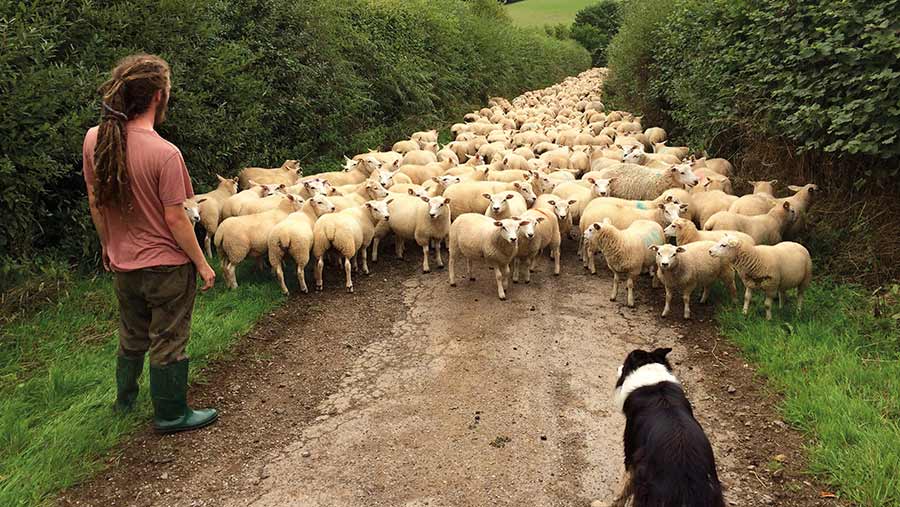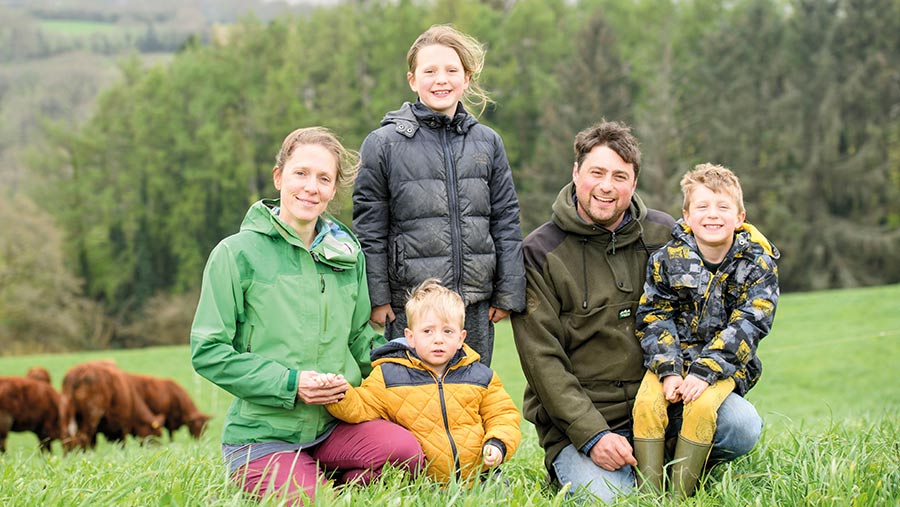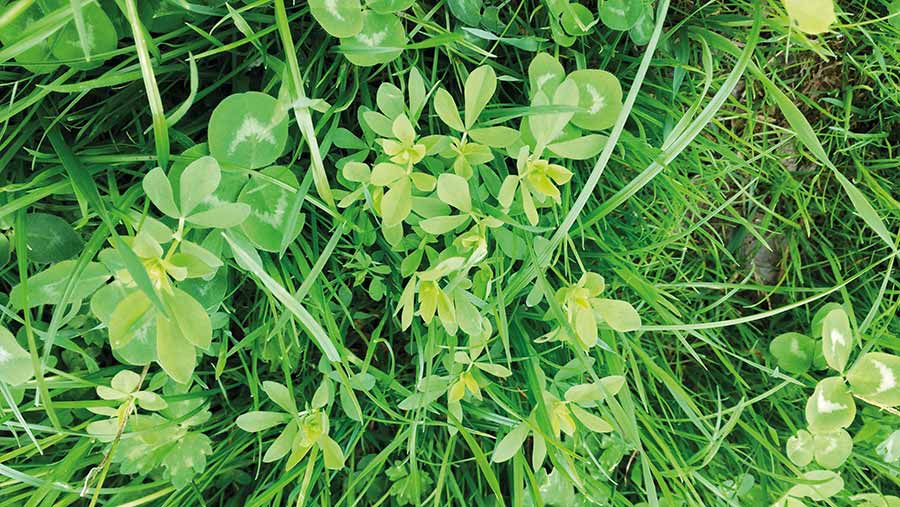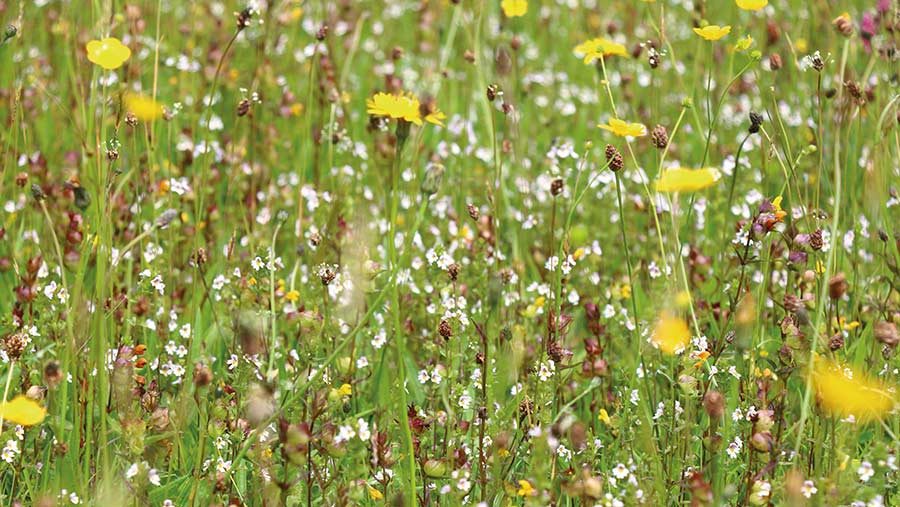First-gen farmer revives livestock farm with focus on nature
 Essebeare Farm's sheep herd © Olly Walker
Essebeare Farm's sheep herd © Olly Walker First-generation farmer Olly Walker has improved the financial performance and environmental value of his farm by redesigning the landscape to revolve around “nature-focused farming”.
Essebeare Farm, a 95ha (235-acre) organic holding in Witheridge, Devon, is home to a 45-head herd of pedigree Red Ruby Devon cattle and a flock of Lleyn and Exlana sheep.
Today, the farm is a thriving hub where commercial farming and wildlife co-exist – but it did not always look this way.
See also: Benefits of soil mapping for forage production
Farm facts

The Walker family © Adrian Sherratt for The Guardian
Essebeare Farm, Witheridge, Devon
- 95ha (235-acre) organic farm
- Comprising grassland, hay meadows, woodland and country wildlife priority sites
- Pasture For Life-certified
- 45-head Red Ruby Devon cattle herd
- 200-head flock of Lleyn and Exlana sheep
When Olly, who farms in partnership with his wife, Rachel, and his mother-in-law, Mary Hosier, took on the farm in 2015, the immediate challenge was to address a long-term lack of investment in the land.
He sought the advice of industry mentors, including Peter Scott, an organic sheep farmer who runs a low-input, grass-fed system.
On the grazing front, he worked with James Daniel of Precision Grazing to learn how best to manage the grassland.
The farm had minimal fencing and water infrastructure, and the soil was heavily compacted.
Clay subsoil at about 40-100cm also made parts of the farm prone to waterlogging.
Soil testing showed an average pH of 5, so as a starting point, lime was applied over two consecutive seasons.
Increasing organic matter
Olly also employed a raft of other measures, including diagonal subsoiling, importing manures and even bringing in hundreds of tonnes of excess grass to incorporate and plough down to feed biology and increase organic matter in the soils.
In terms of the livestock, Olly started with a flock of about 400 ewes, which grew to a peak of 484 ewes by 2018.
All sheep lambed outdoors, on grass, with about 700 lambs produced a year, which were sold as stores.
However, this system proved difficult to sustain owing to the heavy labour requirement, too many lambs carried over winter on a wet farm, and worm burdens on the pasture.
In 2018, the family decided to completely overhaul the farm system, including converting to organic production.
“I’ve always been interested in organic,” he says.
“As a startup new entrant, the conversion process was financially attractive and provided vital capital for a struggling enterprise while we got the farm back up and running.”
One of the biggest changes has been significantly reducing ewe numbers.
Since 2019, the flock has fallen from 385 ewes, to 229 last year, and is now sitting comfortably at 156, with a scanning percentage of 168%.
Lambs are now taken to finishing weight, which has simplified the system hugely and proven to be more cost-effective by generating a higher price/kg than the previous system.
Rotational grazing is still at the core of the system, but he has changed tack with genetics, aiming to breed sheep that better fit the landscape.
He now targets traits akin to those sought by upland farmers and today the farm runs one pure Lleyn mob and one pure Exlana.
“We birth-record lambs from dams via EID [electronic identification] and use a handheld reader to plot growth and select replacement ewe lambs based on maternal traits and good milk supply. What we’re looking for is a sensible, small, efficient, low-input ewe,” Olly explains.
“Exlana shed their wool, but we are selling wool for £1.45/kg to an organic mattress company that collects direct.”
This stringent approach to replacement selection is helping reduce the labour burden by making the flock more resilient, he says, adding that he has recently started benchmarking with the AHDB to compare his performance to national figures.
To help tackle worm burdens, beef cattle were introduced.
These rotationally graze in mobs on daily moves, alternating with the sheep, from May to November – or longer if the season allows.

© Olly Walker
Herbal leys
To improve the resilience of the grassland and the grazing, Olly also grows herbal leys.
These are rotationally grazed and are sown via direct reseeding, overseeding and slot seeding.
Annual reseed area is approximately 4ha (10 acres) and a ley is down for five to seven years.
Spent leys are cultivated in August and go into a diverse forage cover crop mix containing 12 species as a minimum.
“The following spring, we establish an arable silage crop at a seed rate of 35kg/ha, with a herbal ley mix broadcast on top using the quad spinner.
“The idea has been to cheat the dry starts to the year by having peas and barley as a novel nurse crop and trapping moisture for the establishing ley.”
After nine weeks’ growth, the pea barley is cut and baled, leaving the new herbal ley ready for weaned lambs.
The arable silage goes to young beef cattle in winter after weaning.
Environmental measures
Olly has also been working to restore biodiversity on the farm.
The aim of this is to benefit the wider environment and provide a more resilient landscape for the commercial livestock.
The farm’s first Higher Level Stewardship (HLS) agreement was introduced in 2017 and ran for five years.
This enabled a lot of infrastructure to be put in place that facilitated some of the bigger changes that are now present on farm, he explains.
Today, this includes 28ha (69 acres) of restored hay meadows, 7ha (17 acres) of woodland and 24ha (59 acres) of permanent pasture/county wildlife priority sites.
“The hay is used for cattle feeding and bedding. We try not to buy straw and use rush hay and woodchip instead,” he says.
As well as saving on cost, this is also better for the farm’s carbon footprint.
The HLS agreement also covered fencing costs, and reinstatement of lost earth banks – a traditional feature of the Devon landscape, important for grazing management and wildlife, says Olly.
There are plans to build another 800m of banks under a new stewardship agreement, with work to start this summer.
Olly has also incorporated avenues of goat willow, apple trees and hazel trees across pasture over the past five years to help manage grazing.
The trees could eventually form further income streams, such as cider making and thatching materials, he says.
On-farm ponds have been restored to protect local watercourses by catching run-off and sediment from the land, which slopes towards the Sturcombe and Little Dart rivers.

© Martin Wright
The benefits
Despite having fewer lambs to sell, the changes to the farming system have resulted in an uplift in turnover through a better lamb price and a reduced labour requirement, says Olly.
Restoration of the hay meadows has resulted in an increase in species diversity from a baseline of five species/sq m to more than 15.
As well as improving biodiversity, the woodland acts as a “green barn”, providing valuable shade for stock in the warmer months.
“There are about 4ha [10 acres] of woodland available to cattle and sheep,” says Olly.
“We can put them in there in the autumn as well and unroll forage bales via the quad bale trailer. We tend to do this every other year.”
Biological analysis funded by the Devon Wildlife Trust has shown improved organic carbon stocks and an increased Solvita CO2-Burst score following all the changes made at Essebeare Farm.
This score is a measure of carbon dioxide respiration that provides insight into the microbial activity within soils.
The target is above 70 parts/million (ppm), but in his most recent analysis, Olly achieved a score of 143ppm in some of his grassland fields.
This score is an indicator of optimum soil health, nutrient release and carbon sequestration, which Olly believes will be imperative for all farmers to achieve as agriculture moves closer towards the post-BPS era
